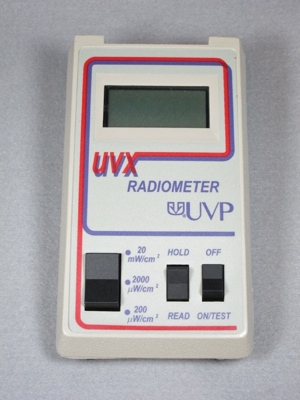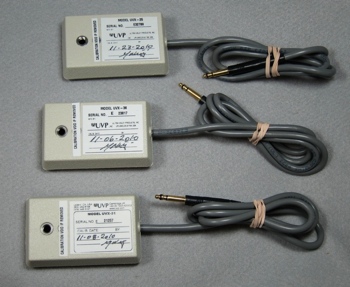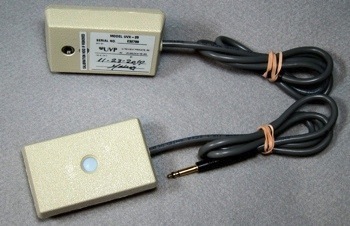C-7 Home Page
Distribution
Accessories ![]() Products
& Services
Products
& Services ![]() Product Lines
Product Lines ![]() Order
Order ![]() Consignment
Consignment ![]() Library
Library ![]() Search C7.com
Search C7.com
![]() UVP Index & Overview
UVP Index & Overview ![]()
![]() Notes & Interesting Articles
Notes & Interesting Articles ![]()
![]() Products Index
Products Index
![]() Biomed
Biomed ![]() Cabinets
Cabinets ![]() Lamps
Lamps ![]() Safety Gear
Safety Gear ![]() Transilluminators
Transilluminators

UVP Model UVX Digital Radiometer
This comparatively small investment can pay for itself many times over. By using the UVX to periodically measure the radiant energy of ultraviolet sources can help to insure your production lines or experiment results are more consistent. With the UVX you can evaluate whether or not employees are being exposed to any ultraviolet, and of so then using the UVX can help your safety people to plan a better environment through simple adjustments to how the source is placed, by shielding, or by adjusting distance. You can determine if your terrarium ultraviolet lamp complies with recommended dosage levels for your pet. Simply put the UVX Digital Radiometer is a must when for safety or for quality assurance a guess is not good enough.
Right: UVP UVX Digital Radiometer (23,553 bytes).
The UVX Digital Radiometer is provided as a cased set. This consists of the handheld UVX Radiometer device shown at right, combined with an optional UVX Sensor (sometimes referred to as a probe) that is optimized for reading energy in the working portion of the ultraviolet. Simply insert a 9 volt transistor battery into the compartment at the rear of the UVX Digital Radiometer, place the appropriate UXV Sensor in place of the target of the illumination or at the same distance to the ultraviolet source as the subject of the study, attach the UVX Sensor cable plug into the UVX Radiometer, then turn the UVX on to obtain your readings. For convenience of the operator you can select to hold the reading before moving the sensor away from the ultraviolet.
The UVX Digital Radiometer provides a readout of the intensity of ultraviolet energy at any one of three ultraviolet spectrum sectors with bandwidths centered at either 254 or 302 or 365 nanometers. Ultraviolet light is invisible to the human eye, so it is inappropriate to use the term 'footcandles' to quantify this energy, instead Watts per Square Centimeter is the appropriate term. So the measurement provided by the UVX is expressed as Milliwatts per Square Centimeter (mW/cm2) or Microwatts per Square Centimeter (µW/cm2). For additional information about this refer to our applications bulletins "Determining Occupational Exposure Limits to Ultraviolet Radiation" and "Measuring Black Light Intensity"
Once the UVX has been turned On, a one second "Self-Test Mode" provides immediate indication if all LCD segments (numerals, decimal points, and
colon) are operative.
The UVX Digital Radiometer panel has a rocker switch so that you can set the UVX in anticipation of to range of intensities:
WARNING: Because of its sensitivity to high heat the UVX Radiometer and its Sensors are not recommended for use in ultraviolet curing systems, or in environments above 122 Deg. F (50 Deg. C).
Right: the three available UVX Sensors for use with the UVX Digital Radiometer (50,478 bytes).
Optional interchangeable Sensors for the UVX Digital Radiometer:
PN 97-0016-01: UVX-25 Sensor, Shortwave. Calibration point 254nm, Bandpass 250-290nm
Full face-on exposure of the sensor to the source while recommended is not required since accurate readings are still possible. This is because each probe's cosine sensitivity is nearly perfect.
Sensor Accessories:
PN 98-0035-01: Attenuator, providing 10% transmission (10 to 1 reduction)
One common 9 volt alkaline battery will typically provide about 120 hours of operation. The UVX Digital Radiometer will indicate a LOW BATTERY condition by displaying the colon ':' symbol in the LCD panel. When you see this then immediately replace the battery.
Right: UVX Sensor back panel showing the labels and the ¼-20 tpi socket, and a front view showing the sensing port (50,478 bytes).

"when for safety or for quality assurance a guess is not good enough"
 Over time there can be changes of output from many types of ultraviolet sources, usually these are related to solarization or other factors that can result in a decline of ultraviolet intensity from the source. There is an simple way to monitor this, that is to use a radiometer, a calibrated device made to measure the emissions from the source. For work in the ultraviolet Company Seven recommends our clients buy our simple to use but reliable UXV Digital Radiometer.
Over time there can be changes of output from many types of ultraviolet sources, usually these are related to solarization or other factors that can result in a decline of ultraviolet intensity from the source. There is an simple way to monitor this, that is to use a radiometer, a calibrated device made to measure the emissions from the source. For work in the ultraviolet Company Seven recommends our clients buy our simple to use but reliable UXV Digital Radiometer.
 Sensors the UVX Radiometer relies on one of the three optional calibrated sensors to provide the intensity measurements. Each sensor consists of a Sensor Housing, a three foot (0.9m) long cable, and a phono style plug; this arrangement allows the placement of the probe in hard-to-reach locations. Simply slide the sensor plug into the port at top of the UVX Radiometer, the port is at top left on the housing. Each sensor incorporates a socket at the rear so that the sensor may be installed, held place by means of a common ¼ inch 20 tpi (threads per inch) camera tripod bolt.
Sensors the UVX Radiometer relies on one of the three optional calibrated sensors to provide the intensity measurements. Each sensor consists of a Sensor Housing, a three foot (0.9m) long cable, and a phono style plug; this arrangement allows the placement of the probe in hard-to-reach locations. Simply slide the sensor plug into the port at top of the UVX Radiometer, the port is at top left on the housing. Each sensor incorporates a socket at the rear so that the sensor may be installed, held place by means of a common ¼ inch 20 tpi (threads per inch) camera tripod bolt.
PN 97-0016-04: UVX-31 Sensor, Mediumwave. Calibration point 310nm, Bandpass 280-340nm
PN 97-0016-04: UVX-36 Sensor, Longwave. Calibration point 365nm, Bandpass 335-380nm
 The UVX Radiometer has been engineered to make operation as fool-proof as possible. Incorporating a continuous battery monitor, the "Battery Condition Indication" LCD warns the operator of insufficient voltage to prevent inaccurate readings. Even if the battery is installed backwards, then the "Reverse Battery Correction" feature stops the current flow immediately to protect the internal circuitry.
The UVX Radiometer has been engineered to make operation as fool-proof as possible. Incorporating a continuous battery monitor, the "Battery Condition Indication" LCD warns the operator of insufficient voltage to prevent inaccurate readings. Even if the battery is installed backwards, then the "Reverse Battery Correction" feature stops the current flow immediately to protect the internal circuitry.
- Temperature: 32 to 122 Deg. F (0 to 50 Deg. C)
- Humidity: 5 to 90% RH
 UVX Radiometer Users Guide illustrated fourty-two page brochure describing the specifications, calibration, and use of this portable radiometer and its optional sensors for measuring UV-A, UV-B, or UV-C. UVP publication No. 81-0064-01 Rev. K. Download size is 3,421,989 bytes (in Acrobat Reader ".pdf" format).
UVX Radiometer Users Guide illustrated fourty-two page brochure describing the specifications, calibration, and use of this portable radiometer and its optional sensors for measuring UV-A, UV-B, or UV-C. UVP publication No. 81-0064-01 Rev. K. Download size is 3,421,989 bytes (in Acrobat Reader ".pdf" format).
 Measuring Black Light Intensity an explanation of the major problems associated with optical radiation measurements, and a guide about how the reader may obtain more accurate and meaningful measurements. Primary emphasis is on measuring irradiance using the UVP J-221 Radiometer. UVP two page illustrated Application Bulletin T-001 from 1977, download size is 289,598 bytes (in Acrobat Reader ".pdf" format).
Measuring Black Light Intensity an explanation of the major problems associated with optical radiation measurements, and a guide about how the reader may obtain more accurate and meaningful measurements. Primary emphasis is on measuring irradiance using the UVP J-221 Radiometer. UVP two page illustrated Application Bulletin T-001 from 1977, download size is 289,598 bytes (in Acrobat Reader ".pdf" format).
 Determining Occupational Exposure Limits to Ultraviolet Radiation Exposure to certain wavelengths of ultraviolet radiation will cause injury to the skin and eyes. This illustrated article explains phosphor-coated emitters, continuum emitters, 254nm line low pressure sodium emitters, how to measure the intensity of ultraviolet exposure, and from this measurement how to determine a safe Permissible Exposure Time (PET) limit. This UVP four page Application Bulletin AN A114 also refers to National Institute of Occupational Safety and Health (NIOSH) standards. This download size is 224,078 bytes (in Acrobat Reader ".pdf" format).
Determining Occupational Exposure Limits to Ultraviolet Radiation Exposure to certain wavelengths of ultraviolet radiation will cause injury to the skin and eyes. This illustrated article explains phosphor-coated emitters, continuum emitters, 254nm line low pressure sodium emitters, how to measure the intensity of ultraviolet exposure, and from this measurement how to determine a safe Permissible Exposure Time (PET) limit. This UVP four page Application Bulletin AN A114 also refers to National Institute of Occupational Safety and Health (NIOSH) standards. This download size is 224,078 bytes (in Acrobat Reader ".pdf" format).
 Solarization When many optical components are exposed to ultraviolet radiation they undergo changes that reduce their ability to transmit UV light, this phenomenon is called solarization. This is particularly a problem in those few elements that lose the ability to transmit UV rapidly. This three page illustrated article helps the reader to understand how solarization affects the different types of lamps. UVP Application Bulletin A-l 12, download size is 224,078 bytes (in Acrobat Reader ".pdf" format).
Solarization When many optical components are exposed to ultraviolet radiation they undergo changes that reduce their ability to transmit UV light, this phenomenon is called solarization. This is particularly a problem in those few elements that lose the ability to transmit UV rapidly. This three page illustrated article helps the reader to understand how solarization affects the different types of lamps. UVP Application Bulletin A-l 12, download size is 224,078 bytes (in Acrobat Reader ".pdf" format).
- UVP Lamps Overview, a review of UVP ultraviolet sources and their differences.
 Operation for the convenience of our customers, the back panel of the UVX Digital Radiometer has a label that also reviews the basic operation procedure:
Operation for the convenience of our customers, the back panel of the UVX Digital Radiometer has a label that also reviews the basic operation procedure:
1. Plug in the appropriate UVX sensor to the UVX Radiometer.
2. Place the UVX Sensor into the ultraviolet environment.
3. For normal operation set the HOLD/READ rocker switch to READ
4. Push OFF/ON-TEST rocker switch down to ON-TEST position: the display will indicate '1888' for one second indicating all LCD panel segments are working.
5. Change the range selector rocker switch to yield the highest resolution. Note a blanked display indicates over range. When the over range indication occurs you should push the rocker switch to select a higher sensitivity range to enable a correct measurement.
6. To hold the display setting at its current level indication set the HOLD/READ rocker switch to HOLD.
Once the range changes have been made, the zero adjust is set to read 00.0 on the LCD. The sensor can then placed in the ultraviolet environment and the intensity reading will be shown on the display. The "Chart Recorder Output" port provides continuous monitoring data to an optional external recording device.
Calibration Calibrations of the UVX Radiometer and of the Sensors are performed at the factory. These are accurate to within ±5% and traceable to the National Bureau of Standards. Linearity is proven and checked to within ±1% over the total operating range. Each UVP Radiometer and each Sensor are provided with certificates and labels indicating the component's serial number, date of the most recent calibration, and the name of the person certifying this information.
The UVX short wave and mid-range sensors are equipped with a UVG filter which solarizes at such a slow rate so that the lifespan of these two sensors is dramatically increased for thousands of hours of high sensitivity transmission. Regardless, we recommend bi-annual calibration of the sensor and the radiometer to assure accurate and consistent measurements.
The calibration cannot be performed in the field but must be done at the factory. So if you require continuous monitoring then Company Seven recommends having a spare radiometer and sensor on hand for intervals when one is rotated to Company Seven or to the factory direct for calibration.
Additional Reading:
Company Seven hosts numerous articles and users guides at our UVP Notes & Interesting Articles page and in our Library including:
 WARNING Infrared and ultraviolet wavelengths are invisible to the human eye yet these electromagnetic waves bear energy and other information. So any structure that absorbs the light can be damaged by this energy; note how sunlight exposure tans the skin while prolonged exposure fades or breaks down materials. The photons of shorter wavelength carry greater energy therefore, these have the greater potential for causing biological damage. These wavelengths can penetrate the eye or skin cells and can produce heating and energy related biological changes that will modify or destroy cellular DNA; this is among the reasons why some UV light sources are used for germicidal (sterilizing) applications.
WARNING Infrared and ultraviolet wavelengths are invisible to the human eye yet these electromagnetic waves bear energy and other information. So any structure that absorbs the light can be damaged by this energy; note how sunlight exposure tans the skin while prolonged exposure fades or breaks down materials. The photons of shorter wavelength carry greater energy therefore, these have the greater potential for causing biological damage. These wavelengths can penetrate the eye or skin cells and can produce heating and energy related biological changes that will modify or destroy cellular DNA; this is among the reasons why some UV light sources are used for germicidal (sterilizing) applications.
As amazing as it can be to explore the ultraviolet spectrum, this is not child’s play! For a good overview of working in the UV and explanations of proper precautions consult Ultraviolet Spectrum Primer, the illustrated article by Company Seven explaining the ultraviolet (UV) spectrum as it applies to photographing or imaging objects in the UV and about observing fluorescence, phosphorescence, and tenebrescence. The article explains the different portions UV spectrum including UV-A (long wave), UV-B (mid) and UV-C (short wave). This also goes into a discussion of imaging gear including lenses, films and filters. Then refer to our article Ultraviolet Personal Safety Gear.
Ordering UVP Products
Company Seven stocks some of the more popular UVP lamp and cabinet products, and we accept orders for their other products by numerous means. You can also bring your UVP item to Company Seven for repair, or contact us to obtain user-serviceable items (bulbs, grids, etc.). The ways by which you may order products or parts are outlined at
Company Seven has not become convinced that on-line ordering is always beneficial for the customer, particularly when making a more complicated choice. While on-line ordering certainly is convenient and time effective for the merchant since they do not have to spend time with the customer, the customer is not always making the best choices when buying solely after reading what may be "propaganda" on line. The best ways to make the better choices are to either visit our showroom, or telephone 301-953-2000. This way you can obtain prompt and competent concise assistance which will address your particular needs and concerns.
Contents Copyright 1994-2010 Company Seven and UVP - All Rights Reserved

